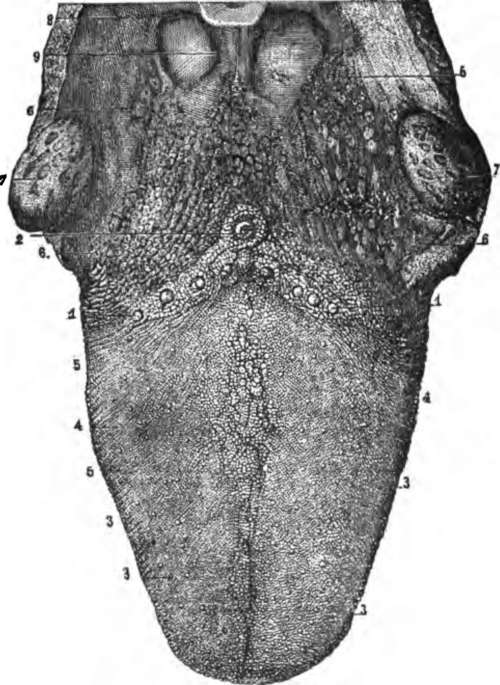Taste
Description
This section is from the book "The Human Body: An Elementary Text-Book Of Anatomy, Physiology, And Hygiene", by H. Newell Martin. Also available from Amazon: The Human Body.
Taste
The organ of taste is the mucous membrane on the upper side of the tongue, and possibly on other parts of the boundary of the mouth cavity. The mucous membrane of the tongue presents innumerable elevations or papillse (Fig. 46) of three kinds (p. 159). The filiform papillę are organs of touch, for the tongue has the sense of touch as well as of taste. The circumvallate and fungiform papillse contain the endings of branches of the glossopharyngeal and trigeminal nerves (pp. 325, 324), which, when excited by sapid bodies, stimulate the taste-centres in the brain.
Many so-called tastes (flavors) are really smells; odoriferous particles of substances which are being eaten reach the nose through the posterior nares and arouse smell sensations which, since they accompany the presence of objects in the mouth, we take for tastes. Such is the case with most spices; when the nasal chambers are blocked or inflamed by a cold in the head, or closed by pinching the nose, the so-called " taste" of spices is not perceived when they are eaten; all that is felt when cinnamon, e.g., is chewed under such circumstances is a certain pungency due to its stimulation of nerves of common sensation in the tongue. This fact is sometimes taken advantage of in the practice of domestic medicine when a nauseous dose, as rhubarb, is to be given to a child.

Fig. 46. The upper surface of the tongue. 1,2, circumvallate papillę; 3, fungiform papillę; 4, filiform papillę; 6, mucous glands.
What is the organ of taste? What is found on the mucous membrane of the tongue? What papilla? are concerned in the tactile sensibility of the tongue? In the gustatory? What nerves supply the taste-papillę?
What are many so-called tastes? Illustrate.
Continue to:
